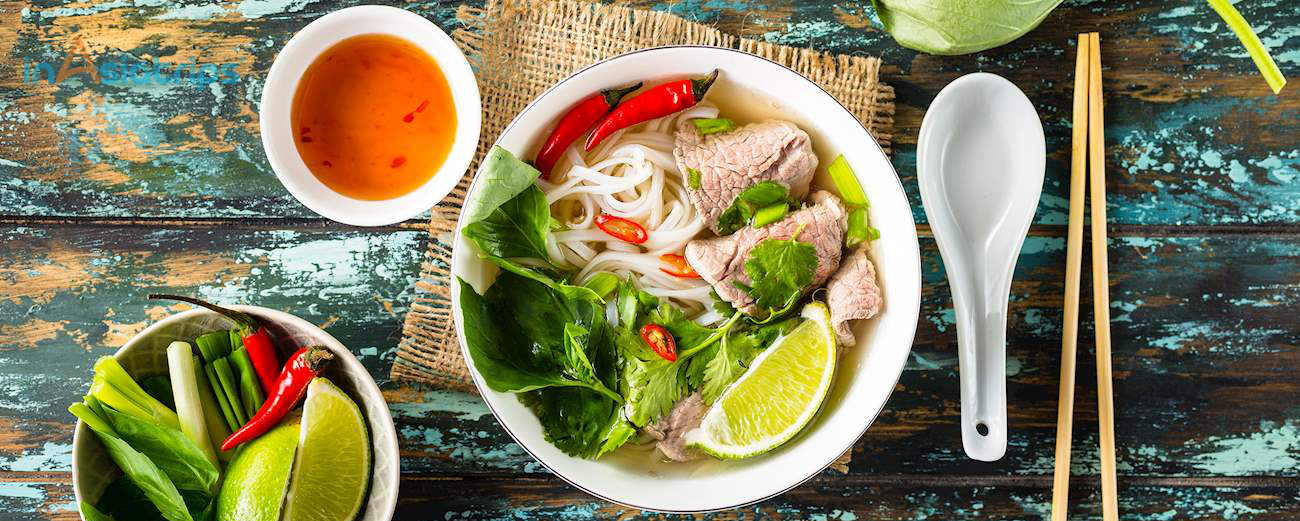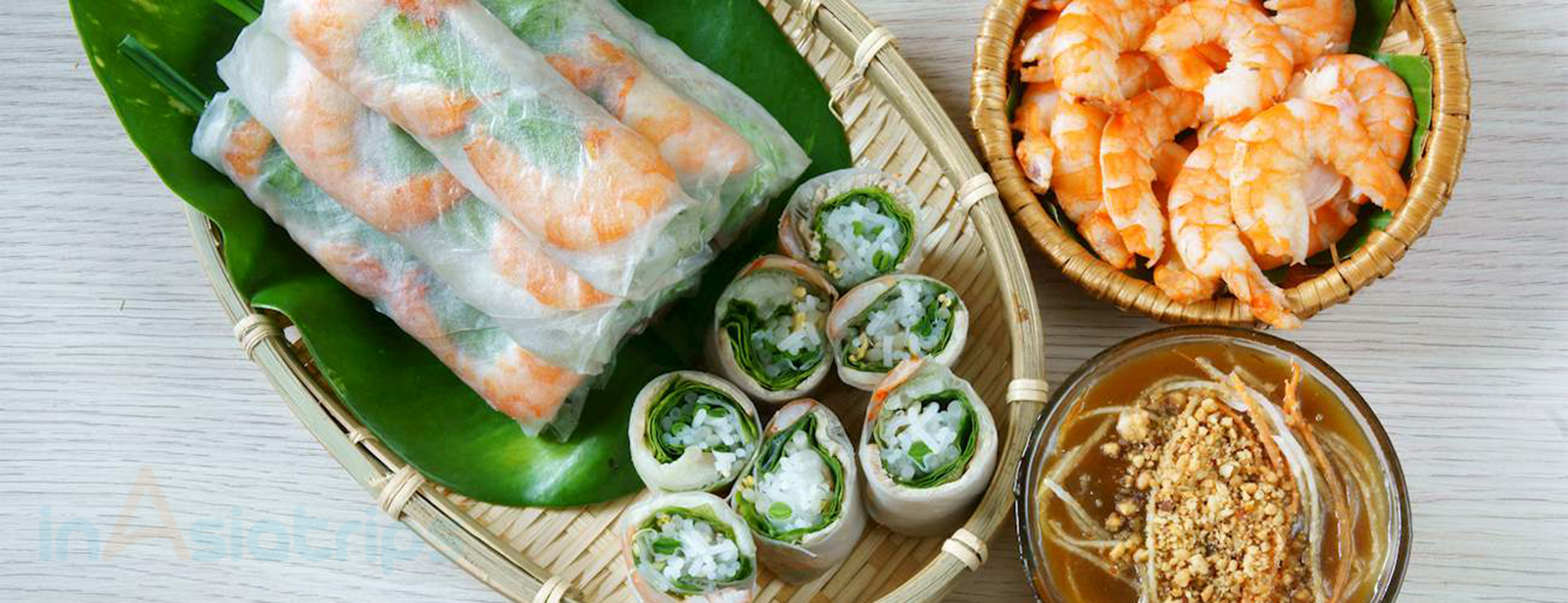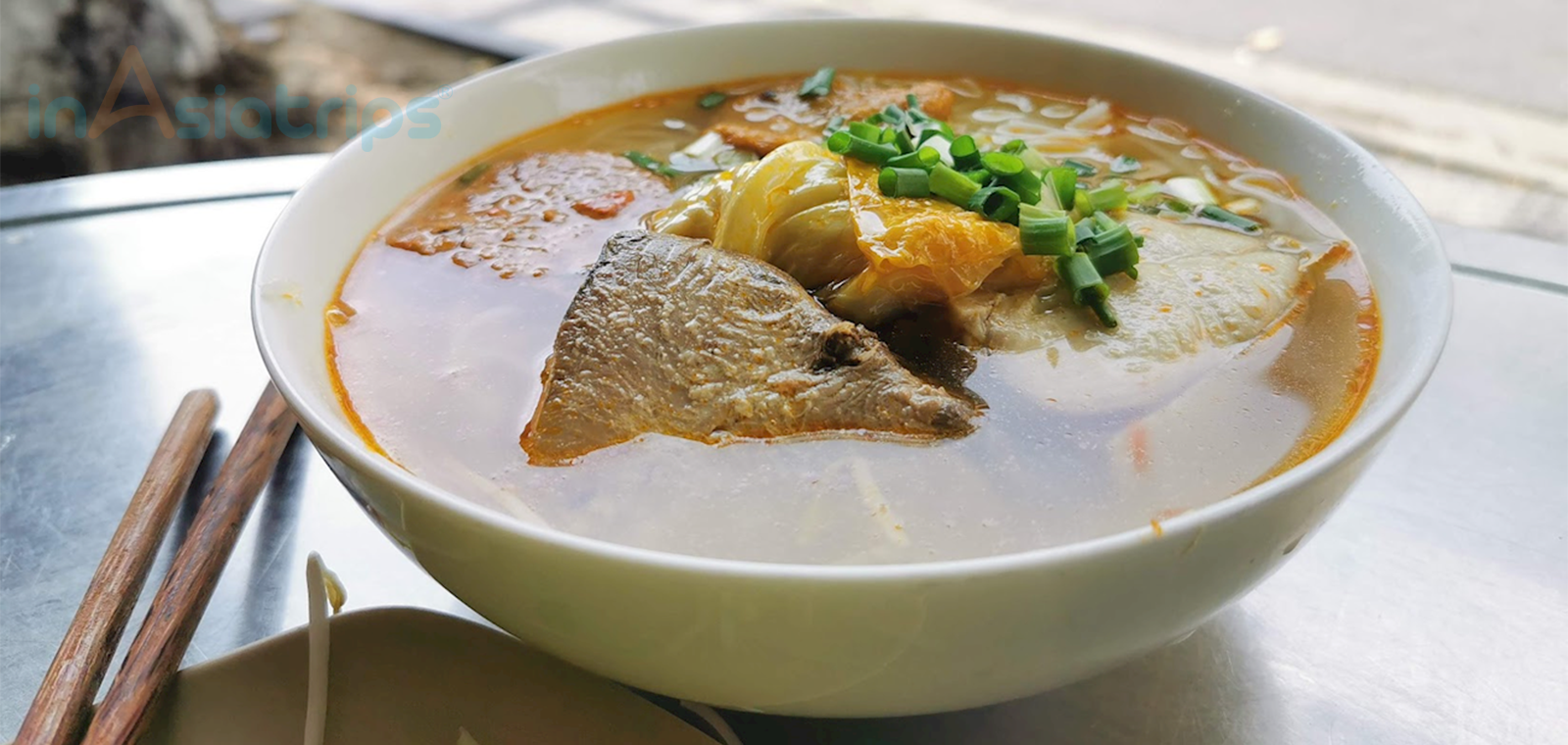Recommended 21 dishes in Vietnam you should try - The best Vietnamese food
Once you travel to Vietnam, the most important part of your trip is to discover the best of local food and dishes. InAsiaTrips Travel & DMC would like to recommend you the best 21 dishes and food of Vietnam that you should try once time when you are in Vietnam, don't miss them as it is really tasted!
===================================
![]() Weather & climate in Vietnam, CLICK HERE
Weather & climate in Vietnam, CLICK HERE ![]() Best time to visit Vietnam, CLICK HERE
Best time to visit Vietnam, CLICK HERE
![]() Best Vietnam Package Tours, CLICK HERE
Best Vietnam Package Tours, CLICK HERE ![]() Tour to Thailand, CLICK HERE
Tour to Thailand, CLICK HERE

Number 1. Vietnamese Phở
Vietnamese Phở is a Vietnamese noodle soup, Vietnam's national dish, street food, comfort food, and a way of life. It is also one of the most beloved Vietnamese dishes in the western hemisphere due to its complex, unique flavors, and elegant simplicity. Although it is classified as a soup, pho is served as the main course and the two bowls of it never taste the same. It is traditionally made with chicken or beef broth, where the bones simmer lazily for at least three hours until the broth is perfect.

Number 2. Bánh Mì
Bánh mì (pronounced 'bun mee') is a popular Vietnamese variety of sandwiches that share the same core ingredient - a baguette. The baguette was brought over to Vietnam during the colonial period, and nowadays it is one of the few happy legacies from the time. The crusty bread, condiments, and meats are all a legacy of French and Chinese colonialism, while cilantro, chili, and pickles reflect the Vietnamese taste for fresh vegetables and bright flavors. In the beginning, most banh mi sandwiches consisted of bread, meat, and seasonings, with no added vegetables. Today, the possibilities are virtually limitless - the sandwiches are stuffed with cold cuts, French butter, fresh mayonnaise, liver pâté, cucumbers, cilantro, pickles, oyster sauce, garlic...and the list goes on. The bread should be light, with a delicate crust and a tender, chewy, and soft interior with a slightly sweet flavor. The meat on the inside can be chicken, pork, beef, seafood, cold cuts, or pâtés, sausages, and terrines, but it is extremely important not to overstuff the sandwich. Most of the fillings and condiments are things that foreigners are unfamiliar with, and that just may be the secret to its popularity.

Number 3. Broken Rice (Cơm tấm)
Cơm tấm is a traditional Vietnamese dish that's typically sold as street food. It consists of broken and imperfect rice grains that were traditionally chucked away after the milling process, but nowadays it's a signature dish of Ho Chi Minh City. Broken rice has a texture that's similar to normal rice, just smaller. When served, cơm tấm is accompanied by numerous toppings such as fried eggs, shredded pork skin, grilled pork chops, or deep-fried fish patties. The usual garnishes include lime wedges, chopped spring onions, and mint, while accompaniments served on the side include sliced tomatoes and cucumbers, pickled vegetables, or dipping sauces. Local cơm tấm eateries are easily found because they usually have a coal-fired grill on the street, dispersing the smoke scented with lemongrass and charred meat, a result of preparing the accompaniments for broken rice. In the past, these broken rice grains were usually used as animal feed or eaten by the farmers and their families. While it's prepared in a number of ways, the most popular is cơm tấm sườn nướng ốp la. A fried egg is paired with caramelised grilled pork chop and laid out on a generous heap of broken rice. The dish is then slathered with nước chấm, a mixture of chilli, fish sauce and sugar, and a drizzle of green onion oil. The final touches include a side of shredded pickled carrots and daikon, slices of cucumbers and tomatoes, and crushed fried pork rinds and shallots for garnish.

Number 4. Hue Noodle Soup - Bún Bò Huế
Bún bò Huế is a staple Vietnamese soup that is traditionally consumed for breakfast, consisting of pork and beef bones broth, bun noodles, lemongrass, shrimp paste, lime juice, and a variety of herbs. The soup is much spicier than most Vietnamese soups, and its flavor is often described as rich and complex. It originated in the city of Hue, but not much is known about its exact origins or inventor. Usual additions include sliced brisket or crab balls, but every cook makes the dish with slight variations. Many believe that bún bò Huế found its way into mainstream society by way of royal order, and it was influenced by the imperial court's cuisine. Regardless of the origin, the soup remains a delicious and inexpensive breakfast staple.

Number 5. Cao Lầu Hoian (Roasted Pork with Cao Lau Noodles)
Cao lầu is a signature dish from Hội An consisting of noodles made from fresh, locally grown rice, lye solution made with ashes of local trees, and water from the local well (Ba Le). Along with the steamed rice noodles, a bowl of cao lầu also consists of thinly sliced roasted pork (char siu), greens, bean sprouts, croutons that are made with the same ingredients as the noodles, and just a splash of flavorful stock. The origin of the dish is vague, and while some believe it was inspired by Chinese cuisine, some claim that it was modeled on Japanese culinary tradition. Regardless of its origin, cao lầu remains a unique delicacy that is not found outside Hội An.

Number 6. Tam Ky Chicken Rice (Cơm gà Tam Kỳ)
Cơm gà Tam Kỳ is a traditional Vietnamese dish originating from the beach town of Tam Kỳ, hence the name. The dish is assembled in layers, with yellow-tinted rice that's cooked in chicken broth, aromatic herbs, and chicken that's boiled with ginger, turmeric, and green onions, then shredded. The leftover water from boiling the chicken with spices is used to cook the rice, and that's the reason why the rice is yellow-colored when the dish is served. It's often accompanied by a combination of shredded papaya, carrots, chili sauce, and soy sauce.

Number 7. Mì Quảng (Quang-Style Noodles)
This Vietnamese classic consists of a combination of flat rice noodles and yellow egg noodles that are served with a small amount of flavorful meat broth and crispy fresh vegetables and herbs such as banana blossoms, lettuce, cilantro, scallions, and Vietnamese coriander. The dish is incredibly versatile and usually comes topped with pork belly, chicken, shrimps, fish, boiled eggs, roasted peanuts, and fish crackers. Though it originated in Central Vietnam, more precisely the Quảng Nam Province, mì quảng is nowadays enjoyed throughout the country.

Number 8. Bánh Xèo (Crispy Vietnamese Pancake)
Loosely translated as sizzling pancakes, bánh xèo is a famous Vietnamese dish that combines crunchy crêpes with a variety of savory ingredients. The distinctive Vietnamese element in these nourishing pancakes is rice flour, which is combined with water, turmeric, and coconut milk or coconut cream in order to create the thick yellow batter. Bánh xèo is eaten everywhere in Vietnam, with slight regional differences in ingredients. Traditionally, it is served in a unique way, usually complemented with vegetables such as lettuce, carrots, and cucumbers, heavily seasoned with fresh cilantro, mint, and parsley. Famous nuoc cham sauce, made with fish sauce, lime juice, sugar, chopped chili peppers, and garlic is typically served alongside bánh xèo. The pancakes are always freshly prepared and are supposed to be torn in larger pieces, which are usually wrapped in lettuce or rice paper and eaten by hand.
.png)
Number 9. Bún Chả (Grilled Pork Meatballs with Vermicelli Noodles)
Bún chả is a pork and noodle dish that is intricately connected to Hanoi, where it is believed to have originated. The dish combines three elements: a bowl of grilled pork meatballs served in a cold broth, a plate of rice noodles, and a combination of various fresh greens such as perilla leaves, lettuce, coriander, and morning glory. Although bún chả or similar varieties can be found in other parts of Vietnam, the local Hanoi version is held in high regard. Not much is known about its history or origin, but the dish became internationally recognized in 2016 when it was featured on the show Parts Unknown – in which the host Anthony Bourdain enjoyed bún chả together with the former president Barack Obama.

Number 10. Xôi
Xôi is one of Vietnam's favorite foods that is easily found anywhere from numerous roadside vendors to traditional and upscale restaurants. Made with a base of steamed sticky rice, these dishes can be made in savory - xôi mặn, or sweet versions - xôi ngọt. They are traditionally served in a banana leaf, and most commonly enjoyed either as a cheap and scrumptious on-the-go breakfast meal, a mid-day snack or a dessert, although in many mountainous areas of northern Vietnam people eat xôi as a main dish. There are over 20 types of xôi ngọt; but if you’re hoping to mesmerised, you’re in luck. Xôi ngũ sắc, the five-coloured xôi, is a psychedelic swirl of purple, green, red, yellow, and white, pigmented using natural plant extracts.

Number 11. Bánh Bèo (Vietnamese Steamed Savory Rice Cake)
Bánh bèo is a popular Vietnamese steamed cake consisting of key ingredients such as rice flour, fish sauce with green chili peppers, and either shrimps or pork. Additionally, noodles, roasted peanuts, or fried onions can be added to the cake in order to improve its flavors. Apart from savory cakes, there are also sweet versions which are almost exclusively available in Hội An.Bánh bèo is traditionally served in a porcelain bowl with a bamboo spoon for consumption. Some people refer to it as the Vietnamese version of tapas, and it is believed that the most important characteristic of a good bánh bèo is an indentation in its center which is used for holding the flavorful, savory stuffings.

Number 12. Bún Riêu (Tomato and Crab Noodle Soup)
Bún riêu is a crab-based Vietnamese noodle soup. The dish is made in several versions, but the most popular one is made with a tomato base and goes under the name bún riêu cua. The soups are prepared with different broths, but they are always infused with crab paste and come served with vermicelli noodles, while the toppings typically include crab meat, pork, tofu, tomatoes, blood jelly, and a selection of fresh greens such as perilla or bean sprouts. The combination of sweet and sour flavors make bún riêu one of the favorite noodle dishes in the country.

Number 13. Gỏi Cuốn - Vietnamese Summer Rolls
These crispy summer rolls are prepared by wrapping soaked rice paper (bánh tráng) around various ingredients. Although the most common combinations include meat or seafood - usually beef, pork, shrimps, or crab meat, as well as rice vermicelli noodles - the stars of the dish are fresh and aromatic herbs and vegetables such as mint, cilantro, cucumbers, or mushrooms. The rolls are always served at room temperature or well-chilled, and they're usually accompanied by nước chấm (fish sauce), peanut sauce, or hoisin sauce. Interestingly, these Vietnamese rolls were included in the list of the world's 50 best foods by CNN.

14. Bánh Căn - Vietnamese Mini Pancakes
These savory Vietnamese pancakes are made with a thin rice flour batter. They are cooked on outdoor grills which are equipped with a specialized terracotta bánh căn mold. The mixture is poured into the mold, and the pancake is then topped with a whole shrimp and scallions, or optionally pork or quail eggs. The pancakes are usually served with a fish sauce on the side and various fresh herbs and leafy vegetables which are meant to be used as wrappers. It is not clear when these pancakes first appeared, but their origin is often attributed to Ninh Thuận province, although they are enjoyed throughout South Central region.

Number 15. Hủ Tiếu Nam Vang - Nam Vang Noodle Soup
Hủ tiếu Nam Vang is a popular Vietnamese street food with Cambodian-Chinese roots. The dish is named after the Cambodian capital Phnom Penh (Nam Vang), and the recipe is tweaked to adapt to Vietnamese flavors. The noodle soup should have a clear and rich broth made from pork bones, pork, and dried squid and shrimp. The noodles can be transparent rice noodles, chewy tapioca noodles, or thin Chinese egg noodles. Toppings include a combination of sliced pork liver, cooked pork meat, sautéed ground pork, quail eggs, fried shallots, garlic, and poached shrimp.

Number 16. Chả Cá - Turmeric Fish with Dill and Noodles
Chả cá Lã Vọng is a traditional Vietnamese dish originating from Hanoi. It consists of grilled fish with turmeric and dill. In order to prepare it, firm white fish such as catfish, cod, or tilapia is usually marinated in shallots, galangal, turmeric, garlic, shrimp paste, fish sauce, and oil. It is then grilled on both sides with dill and spring onions and served with vermicelli noodles, roasted peanuts, and a dipping sauce consisting of lime juice, garlic, fish sauce, and sugar. This dish dates back to the French Indochina days of Vietnam, and the resistance fighters used to meet in the Old Quarter of Hanoi. Their secret meeting place served grilled fish (chả cá), and outside of the establishment, there was a statue of Lã Vọng, a famous poet and resistance fighter, hence the name of the dish.

Number 17. Nộm Hoa Chuối - Banana Blossom Salad
Nộm hoa chuối is a traditional salad originating from Vietnam. It's often made with a combination of banana blossoms, bean sprouts, white vinegar, sesame seeds, green papaya, carrots, coriander, sugar, salt, dried shrimp, roasted peanuts, and lime juice. The salad is prepared in many versions throughout the country, so there's no fixed recipe, but pork or chicken are often added to the mix as well. The ingredients are simply mixed together, tossed, and dressed, and the salad is then served on a platter or a thick banana leaf. It can also be additionally garnished with fried shallots, sliced chili peppers, and even more roasted peanuts on top, if desired.

Number 18. Bánh Cuốn - Steamed Rice Rolls Stuffed with Pork and Mushrooms
Bánh cuốn is a popular Vietnamese street food item consisting of steamed rice rolls stuffed with pork (banh cuon nhan thit), mushrooms (banh cuon than tri), or both (banh cuon Ha Noi). The dish is usually served with a fried shallot dip, sweet and sour fish sauce (nuoc mam chua ngot), a variety of fresh herbs, and lime-based sauce on the side.This savoury treat is always made fresh-to-order, topped with dried shallots and served with a side bowl of fish sauce with pork sausage. Enjoy it for breakfast, like a local, and feel free to add fresh herbs to the mix and brighten up your bite.

Number 19. Bún Chả Cá - Fried Fish Cake Noodle Soup
Bún chả cá is a specialty of Da Nang and a traditional Vietnamese noodle soup topped with fish cakes. The broth for this noodle soup is traditionally prepared with fish or pork bones and tomatoes, while the fish cakes should be prepared from dense, meaty, and firm white fish fillets. Other common ingredients in the soup include vermicelli noodles, fish sauce, shallots, garlic, cilantro, dill, mam tom shrimp paste, and black pepper. The hot broth is ladled over the noodles, and the dish is then topped with fish cakes. Bún chả cá is especially popular in seaside towns.

Number 20. Bún Bò Cuốn Lá Lốt - Beef Wrapped in Wild Betel served with rice noodle
A seared, crispy, leafy layer encases minced beef, garlic and shallots, sealing in juicy bites of bò lá lốt. This southern speciality is unexpected, with a merry meat mix rolled up in betel leaves like a small cigar, grilled over charcoal. The results are stupendous, peppery bursts of flavour that can be enjoyed with noodles or rolled up with rice paper and fresh herbs. Playful textures, dipped in a spicy fish sauce make bò lá lốt a must-try for meat-eaters when in Vietnam.

Number 21. Chè Vietnam - Vietnamese Sweet Soup
Vietnamese chè dishes include any traditional sweet soup, beverage, pudding, or any other custard-like dessert that is made with a base of either water or coconut cream and served either hot or cold. Other ingredients for making chè include various jellies and fruits, beans and pulses, rice and grains, and even tubers and cereals. Cold Chè is filled with jellied ingredients and tropical fruits such as bananas, mangoes and longan, usually doused in coconut cream. Always a textural adventure, you'll be surprised to encounter coconut shreds, crushed ice, lotus seed and jellies in these syrupy snacks. The beautiful three-coloured dessert, chè ba màu is often called the rainbow dessert. This is a layered spectacle of red beans, mashed mung beans and pandan jelly, topped with crushed ice and coconut milk.

===================================================
READ MORE INFORMATION AT:
![]() Weather & climate in Vietnam, CLICK HERE
Weather & climate in Vietnam, CLICK HERE ![]() Best time to visit Vietnam, CLICK HERE
Best time to visit Vietnam, CLICK HERE
![]() Best Vietnam Package Tours, CLICK HERE
Best Vietnam Package Tours, CLICK HERE ![]() Tour to Thailand, CLICK HERE
Tour to Thailand, CLICK HERE

